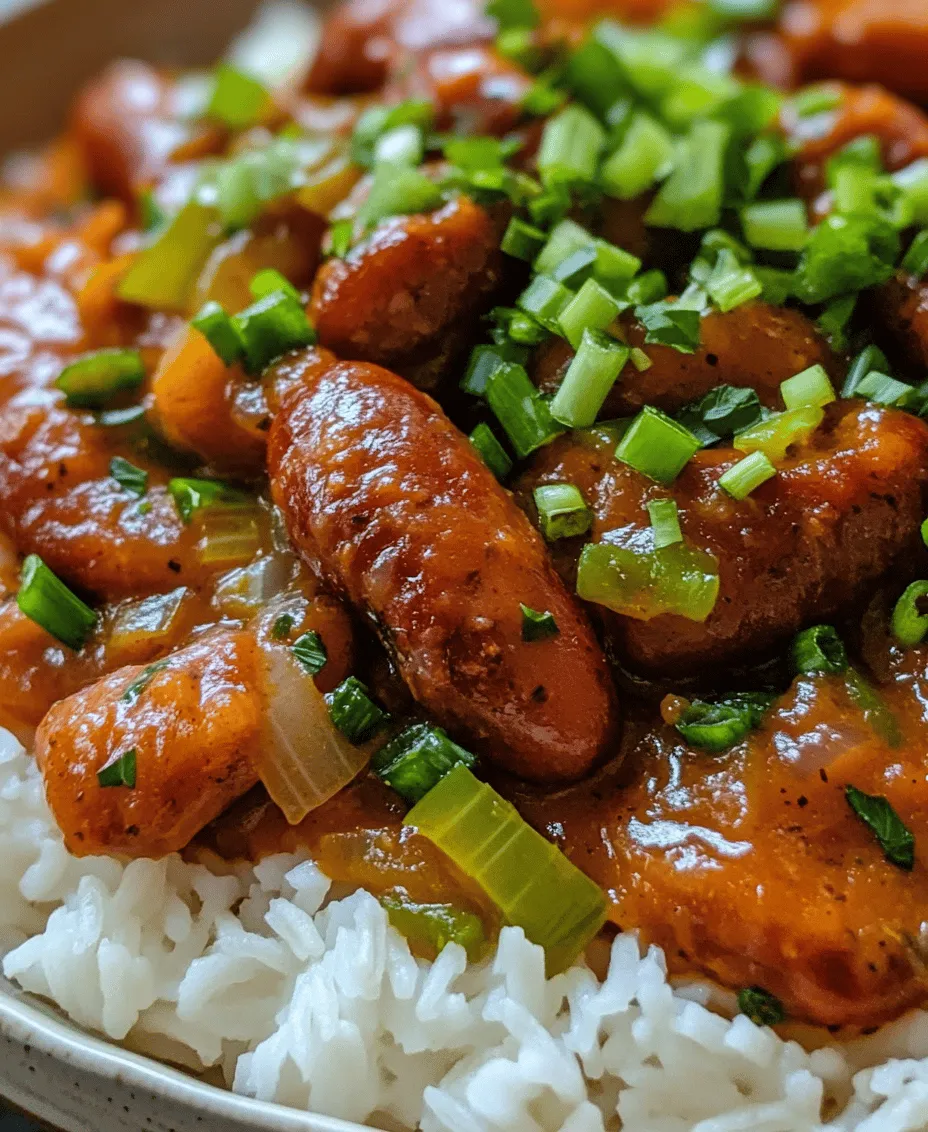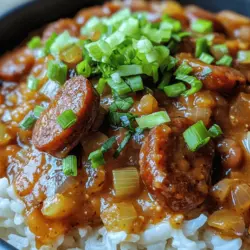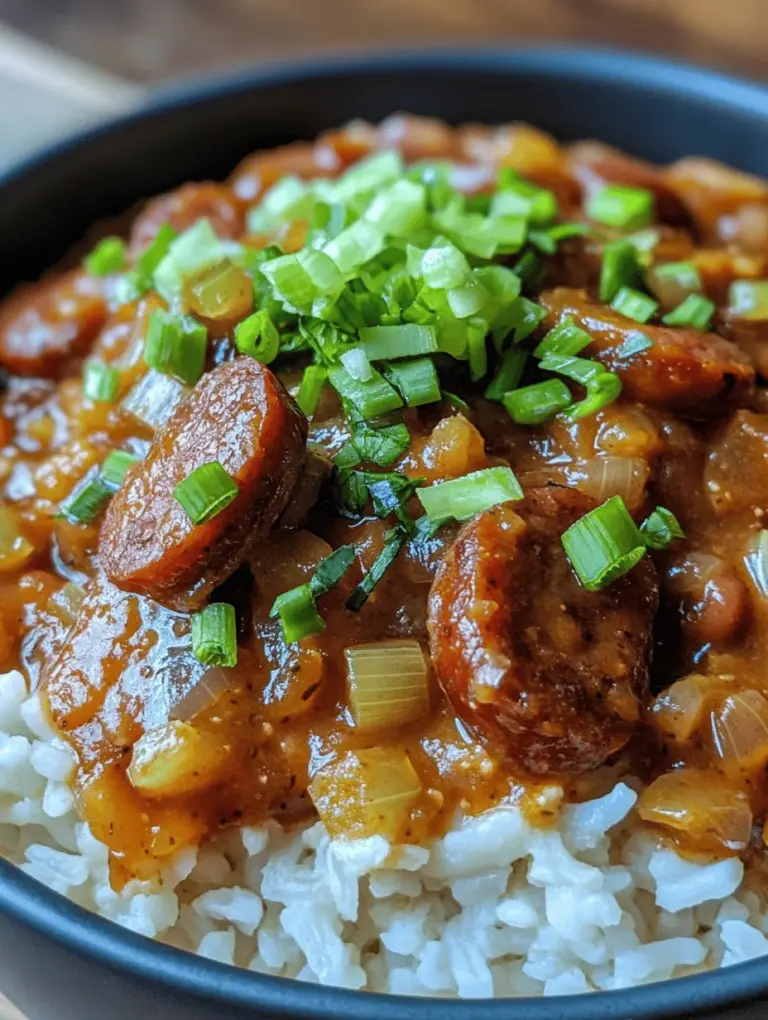Introduction
Southern cuisine is renowned for its rich flavors, comforting dishes, and deep-rooted cultural significance. It tells the story of a region shaped by diverse influences, including African, European, and Native American culinary traditions. Among the many beloved dishes of the South, red beans and rice stand out as a quintessential meal that embodies the heartiness and warmth of Southern hospitality.
Originating as a staple in Louisiana, red beans and rice is more than just a dish; it’s a tradition steeped in history. Traditionally prepared on Mondays—a day often reserved for laundry and chores—this dish was an ideal way to use leftover meats and allow the beans to simmer slowly, infusing them with flavor. Today, it is celebrated across the South and beyond, with families passing down their cherished recipes through generations.
What makes this particular recipe the “best”? It’s the perfect balance of flavors, the harmony of spices, and the depth that comes from slow cooking. With this recipe, you’ll discover how to create a bowl of red beans and rice that is not only delicious but also evokes the essence of Southern cooking.
Understanding Red Beans and Rice
Historical Context
The origins of red beans and rice can be traced back to the early 19th century, particularly in the Creole and Cajun communities of Louisiana. The dish was born out of necessity, utilizing affordable ingredients that were readily available. Dried red beans, often combined with smoked meats, were simmered together with spices and served over rice—a staple grain in Southern diets.
As the dish evolved, it became a symbol of community and comfort, often served during gatherings and celebrations. Today, red beans and rice is not just a meal; it’s a cultural emblem that reflects the resilience and creativity of Southern cooks.
Regional Variations
While red beans and rice is widely recognized as a Louisiana specialty, variations of the dish can be found throughout the Southern United States. In some regions, you’ll find it made with kidney beans or black-eyed peas, while others might incorporate different types of sausage or spices. Each family often has its own twist, reflecting personal tastes and local ingredients.
For instance, in some areas, the dish may be spiced up with hot sauce or served with cornbread on the side. No matter the variation, the heart of red beans and rice remains the same: a comforting dish that brings people together.
Nutritional Benefits
Red beans and rice not only satisfy the palate but also offer nutritional benefits. Red beans are an excellent source of protein, fiber, and essential vitamins and minerals, including iron and potassium. When paired with rice, they create a complete protein, making this dish a nutritious choice for vegetarians and meat-eaters alike. The addition of vegetables and spices enhances its health benefits while adding flavor complexity.
Key Ingredients for the Best Southern Red Beans and Rice
To create the best Southern red beans and rice, you’ll need a handful of key ingredients that come together to deliver an unforgettable dish. Here’s a detailed analysis of each component:
Dried Red Beans
Starting with the beans, the backbone of this dish, dried red beans are essential for achieving the authentic texture and flavor. When selecting beans, opt for small red beans or kidney beans, which hold their shape well during cooking. Always inspect the beans for any debris or stones before soaking them. Soaking the beans overnight not only helps to soften them but also reduces cooking time and enhances digestibility.
Olive Oil
While traditional recipes often call for lard or bacon fat, olive oil is a versatile and heart-healthy alternative. It helps in sautéing the aromatics and adds a subtle richness to the dish. When cooking, choose extra virgin olive oil for its superior flavor and nutritional benefits.
Aromatics: Onion, Bell Pepper, Celery, and Garlic
The holy trinity of Southern cooking—onion, bell pepper, and celery—forms the aromatic base for this dish. Sautéing these vegetables brings out their natural sweetness, adding depth to the overall flavor. Garlic, with its pungent and savory notes, complements the trio beautifully. Together, these aromatics create a flavorful foundation that is essential for any great red beans and rice.
Sausage and Ham
For authentic flavor, incorporating smoked sausage and ham is crucial. Andouille sausage, a staple in Cajun cuisine, is often used for its spicy, smoky characteristics. If you prefer a milder flavor, consider using kielbasa or smoked turkey sausage. Additionally, leftover ham hocks or ham bones can be added for extra richness. The key is to select quality meats that will impart a deep savory flavor to the beans as they cook.
Seasonings: Thyme, Cajun Seasoning, and Bay Leaves
A well-seasoned pot of red beans and rice is essential for creating a dish that truly stands out. Fresh or dried thyme adds an earthy note, while Cajun seasoning provides a blend of spices that can include paprika, cayenne, garlic powder, and black pepper. Bay leaves impart a subtle aromatic flavor during cooking. Be mindful of the seasoning—it’s easier to add more later than to adjust if the dish becomes too salty or spicy.
Chicken Broth
Using chicken broth (or vegetable broth for a vegetarian version) elevates the flavors of the dish. It provides a rich base that enhances the overall taste and helps the beans absorb the spices. Opt for low-sodium broth to have more control over the saltiness of the final dish.
Preparation Steps for Red Beans and Rice
Importance of Soaking Beans
Soaking the beans is a crucial step that should not be overlooked. By soaking dried red beans overnight in water, you help to soften their skins, allowing them to cook more evenly and quickly. This process also helps to reduce the oligosaccharides that can cause digestive discomfort. If you’re short on time, you can opt for a quick soak method: bring the beans to a boil in water for about 2-3 minutes, then remove from heat and let them sit for an hour.
Detailed Cooking Process
Once your beans are soaked and ready to go, the cooking process begins. Here’s a step-by-step guide to making the best Southern red beans and rice:
1. Prepare your ingredients: Drain and rinse the soaked beans. Chop the onion, bell pepper, celery, and garlic, and slice the sausage.
2. Sauté the aromatics: In a large pot or Dutch oven, heat a few tablespoons of olive oil over medium heat. Add the chopped onion, bell pepper, and celery, sautéing until softened, about 5-7 minutes. Stir in the minced garlic and cook for an additional minute until fragrant.
3. Add the sausage and ham: Incorporate the sliced sausage and any ham you’re using, allowing them to brown slightly. This step adds flavor to the base of the dish.
4. Mix in the seasonings: Sprinkle in the thyme, Cajun seasoning, and bay leaves, stirring to combine. This is where the aroma starts to unfold, enticing everyone in the kitchen.
5. Combine the beans and broth: Add the soaked beans to the pot, followed by enough chicken broth to cover everything by about an inch. You can adjust the liquid later, depending on your desired consistency.
6. Bring to a simmer: Increase the heat to bring the mixture to a boil, then reduce to low heat. Cover the pot and let it simmer gently for about 1.5 to 2 hours, stirring occasionally. This slow cooking allows the beans to absorb the flavors of the seasonings and meats.
7. Check for doneness: The beans are ready when they are tender and creamy. If they seem too thick, add more broth or water. Taste and adjust the seasoning as necessary.
As the beans simmer, the kitchen fills with the irresistible scent of Southern cooking, promising a meal that is both hearty and satisfying.
Stay tuned for the next part of this article, where we’ll delve into serving suggestions, tips for achieving the best results, and answers to common questions about this iconic dish.

Sautéing the Aromatics: Tips for Best Results
The foundation of any great Southern red beans and rice dish lies in the aromatics. Sautéing onions, garlic, bell peppers, and celery—often referred to as the “Holy Trinity” of Cajun and Creole cooking—creates a rich, flavorful base. To achieve the best results:
1. Choose Fresh Ingredients: Select fresh vegetables for maximum flavor. A robust onion and crisp celery will enhance your dish, while fresh garlic adds aromatic notes.
2. Control the Heat: Start with medium heat to avoid burning the aromatics. Once the onions turn translucent and the garlic is fragrant, you may need to lower the heat to prevent scorching.
3. Add a Pinch of Salt: This helps draw moisture from the vegetables, allowing them to soften more quickly and enhancing their flavors.
4. Cook Until Just Tender: Aim for a soft and fragrant mix, but don’t overcook; you want the vegetables to maintain some texture for the final dish.
Integrating Meats and the Importance of Browning
Once the aromatics are perfectly sautéed, it’s time to incorporate the meats. Classic recipes often feature smoked sausage and ham hocks, but you can use your favorite smoked meats. Here’s how to integrate them effectively:
1. Browning the Meats: Before adding the beans, brown your sausage in the same pot. This step is crucial as it develops a deep, caramelized flavor that enriches the dish. The rendered fat from the sausage can also be used to continue cooking the aromatics, enhancing the overall taste.
2. Building Layers of Flavor: After browning, remove the sausage and set it aside. Deglaze the pot with a splash of broth or water to lift any flavorful bits stuck to the bottom. Then return the sausage and any other meats to the pot, ensuring each piece is coated in the aromatic mixture.
Seasoning Techniques for a Well-Rounded Flavor
Seasoning is key to achieving a well-rounded flavor profile in your red beans and rice. Here are some effective techniques:
1. Herbs and Spices: Along with salt and pepper, consider adding bay leaves, thyme, and smoked paprika. These spices complement the beans and meats beautifully.
2. Hot Sauce: A splash of hot sauce during the cooking process adds depth without overwhelming the palate. Serve additional hot sauce on the side for those who enjoy an extra kick.
3. Taste as You Go: After adding the beans and liquids, taste your dish periodically. Adjust the seasoning as needed, keeping in mind that flavors will concentrate as the dish simmers.
Cooking the Beans: Timing, Temperature, and Consistency Tips
Cooking the beans to perfection is essential for the overall success of your dish. Here’s how to ensure they are tender and flavorful:
1. Simmer Gently: Once you add the soaked or canned beans to the mixture, bring the pot to a gentle simmer. Too high of a temperature can break the beans and lead to an undesirable mushy texture.
2. Monitor Cooking Time: If using dried beans, they may take anywhere from 1.5 to 2.5 hours to cook, depending on their age. If using canned beans, a simmer of 30 to 45 minutes should suffice.
3. Check for Doneness: Beans should be tender but not falling apart. Test them by tasting a few; they should have a slight bite yet yield easily.
Achieving the Perfect Texture: Mashing Beans for Creaminess
To create that signature creamy texture that Southern red beans and rice is known for, consider mashing a portion of the beans:
1. Mash with a Fork or Potato Masher: After the beans have cooked through, use a fork or potato masher to mash some of the beans against the side of the pot. This will thicken the dish and create a velvety consistency.
2. Stir Well: After mashing, stir the beans thoroughly to incorporate the mashed and whole beans, ensuring a consistent texture throughout the dish.
Serving Suggestions
Red beans and rice can be served in various traditional ways, making it a versatile meal that pleases many palates. Here are some recommendations for serving:
1. Traditional Plating: Serve the red beans over a scoop of fluffy white rice. For an authentic Southern experience, top it with chopped green onions.
2. Accompaniments: Pair your dish with cornbread for a delightful contrast in texture. A side of creamy coleslaw can also balance the dish’s richness.
3. Customizing with Garnishes: Consider adding fresh herbs or sliced green onions for brightness. A drizzle of hot sauce can enhance the flavor, allowing each diner to adjust the heat to their preference.
Cultural Significance and Variations
Red beans and rice is more than just a meal; it embodies Southern hospitality and tradition. This dish is often enjoyed on Mondays, a day for using leftover meats from Sunday’s feast, demonstrating resourcefulness and community spirit.
1. Regional Variations: While red beans and rice is a staple in many Southern homes, variations exist. In Creole cooking, you may find more emphasis on the use of seafood, whereas Cajun recipes may incorporate spicier sausage and additional heat.
2. Modern Twists: Today, many chefs and home cooks explore vegetarian adaptations by substituting meats with smoked paprika or liquid smoke for depth. Others experiment with different beans, such as black beans or pinto beans, while maintaining the dish’s essence.
Common Mistakes to Avoid
To create a flawless pot of red beans and rice, be mindful of these common pitfalls:
1. Overcooking or Undercooking Beans: Always test your beans for doneness. Overcooked beans can become mushy, while undercooked beans can be hard and unappetizing.
2. Misbalancing Flavors: If your dish tastes flat, it might need salt or acidity to brighten the flavors. A splash of vinegar or lemon juice can help achieve balance.
3. Not Allowing Adequate Simmer Time: Patience is key. Allowing the dish to simmer for a sufficient time develops flavors and helps the beans absorb the seasonings fully.
Conclusion
Red beans and rice is a cherished dish that holds a special place in Southern cuisine. Its ability to comfort and nourish while bringing people together around the table is unmatched. Whether you’re preparing it for a family gathering or a quiet dinner at home, this recipe allows you to experience the warmth of Southern hospitality.
As you try your hand at this traditional dish, remember that the journey is just as important as the destination. Embrace the cooking process, adjust the flavors to your liking, and enjoy the rich history and culture that red beans and rice represents. You’ll not only savor the comforting flavors but also create memories that will be cherished around your dining table.

